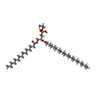+Search query
-Structure paper
| Title | Structure and mechanism of the Mrp complex, an ancient cation/proton antiporter. |
|---|---|
| Journal, issue, pages | Elife, Vol. 9, Year 2020 |
| Publish date | Jul 31, 2020 |
 Authors Authors | Julia Steiner / Leonid Sazanov /  |
| PubMed Abstract | Multiple resistance and pH adaptation (Mrp) antiporters are multi-subunit Na (or K)/H exchangers representing an ancestor of many essential redox-driven proton pumps, such as respiratory complex I. ...Multiple resistance and pH adaptation (Mrp) antiporters are multi-subunit Na (or K)/H exchangers representing an ancestor of many essential redox-driven proton pumps, such as respiratory complex I. The mechanism of coupling between ion or electron transfer and proton translocation in this large protein family is unknown. Here, we present the structure of the Mrp complex from solved by cryo-EM at 3.0 Å resolution. It is a dimer of seven-subunit protomers with 50 trans-membrane helices each. Surface charge distribution within each monomer is remarkably asymmetric, revealing probable proton and sodium translocation pathways. On the basis of the structure we propose a mechanism where the coupling between sodium and proton translocation is facilitated by a series of electrostatic interactions between a cation and key charged residues. This mechanism is likely to be applicable to the entire family of redox proton pumps, where electron transfer to substrates replaces cation movements. |
 External links External links |  Elife / Elife /  PubMed:32735215 / PubMed:32735215 /  PubMed Central PubMed Central |
| Methods | EM (single particle) |
| Resolution | 2.98 Å |
| Structure data | EMDB-11027, PDB-6z16: |
| Chemicals |  ChemComp-PTY:  ChemComp-K: |
| Source |
|
 Keywords Keywords | MEMBRANE PROTEIN / Mrp antiporter / sodium/proton exchanger / bioenergetics / complex |
 Movie
Movie Controller
Controller Structure viewers
Structure viewers About Yorodumi Papers
About Yorodumi Papers





 Anoxybacillus flavithermus WK1 (bacteria)
Anoxybacillus flavithermus WK1 (bacteria)